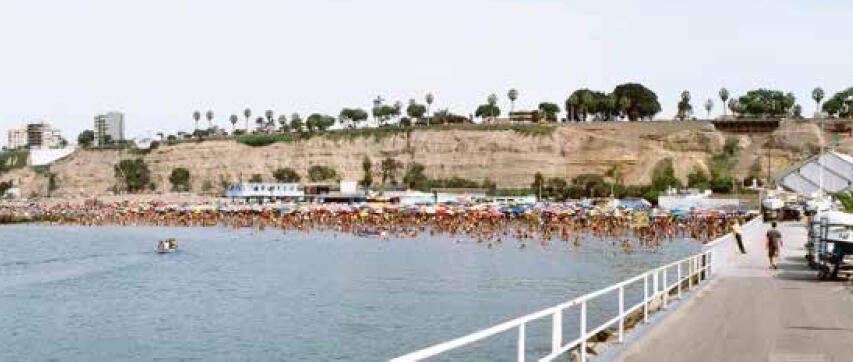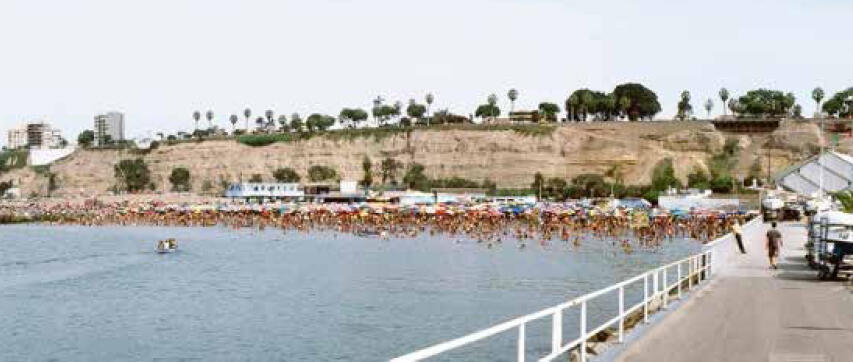Roberto Huarcaya
Political Sightings in a Photographic Process
Since his emergence in the visual arts scene, the photographer Roberto Huarcaya (Lima, 1959) has distinguished himself by the ambition of his projects, in which photography has often been associated with other creative mediums in very solid combinations that have elicited intense responses from different audiences.

His proposals have frequently revolved strongly around the construction of an individual and a collective identity in face of situations ranging from the banal-everyday, through the erotic as a turning point in relation to freedom, finally to reach the political, that is, that which being pertinent to the development of responsibilities, rights and obligations of individuals within a society requires attention, consideration and discussion in order to clarify the ideal of the common good.
In recent times, Huarcaya’s projects have turned towards questionings regarding photography, but without distorting the support of the image; rather, he has attracted the viewer’s attention towards its configuration. The way in which the artist manages to make the role of the witness (the committed gaze) intertwine with the role of the anthropological observer (the gaze that pays attention to the developments and textures of a human situation safeguarding its integrity) is really striking. These recent proposals by the artist have resorted, for example, to cameras traditionally indicated for a work that is clear and categorical in its presentation, but that slows down and dwells on the hidden details and progresses towards its culmination without announcing any conclusions.
Focused on Peruvian society, Huarcaya’s gaze in recent works such as Playa Privada/Playa Pública or Pamplona/Casuarinas is so candid that one might wonder how he eludes producing a pamphlet. The answer lies in the distance that he keeps between himself and the subject to be photographed, and indeed, Huarcaya the individual- photographer-citizen, recognizes in himself the potential of a gaze positioned at an evidently not quantifiable, but indeed verifiable distance, inside a society marked by discrimination in different aspects. In a somewhat similar way as the analysis that Aldous Huxley made of El Greco and his characters, Huarcaya seems to become invisible in the environment without, however, being totally swallowed by an opacity that might erase his photographic trace in response to a critical life experience. What he does in order to assume the questioning position is to adopt a nuclear place in the fabric of society, inside that social organism that regulates, and above all, excludes, in a brutal way.
The artist’s most recent photographic work seems to take a different course, but – as will become evident – this is only apparent. We are referring to an installation of unprecedented dimensions in his body of work covering 25 years. Presented at the Casa Rímac in Lima’s historic district, coinciding with the exhibition of a selection from the Jan Mulder Collection, also temporarily housed in the same venue on account of the presentation of LimaPhoto 2014, his installation Amazogramas – 90 metros de Bahuaja Sonene is the most concrete attention call he has featured to date.
Huarcaya has always been interested in reality as a space for creation and very often he has engaged in pursuing the definition of visual devices that might transform its reading and make it possible to experiment openly and critically with the generation of signs and symbols. The poetic narrative in photographic sequences was a way of exploring that territory, as were the photographic reconstructions of chosen works from the history of Western painting.
For the production of the Amazogramas, he has focused his attention on camera-less photography, and he is creating “photograms”. “Photograms” are images obtained through a process that dispenses with the photographic camera and its lenses, and in which the paper with the photosensitive emulsion acts as a witness to everything that comes into contact with it, capturing its trace in direct relation to its physical presence and size through an adequate handling of light. The historical avant-garde of early 20th century European art resorted to photograms as a radical way out from what was perceived as a complete crisis in representational art. Roberto Huarcaya resorts to them in order to point at an acute-phase crisis in a territory that is, in turn, in an absolutely critical situation in terms of what we insist on terming “national reality”. Once again, Huarcaya chooses to take a distance (paradoxically, in spite of the contact between the parts that photograms demand).
He has produced three photograms for which he has utilized three whole photographic paper webs. In nocturnal actions with the proportions of an independent film production (one cannot but recall the comparable ambition of the Peruvian avant-garde photographers Carlos and Miguel Vargas and their photographic Nocturnos, produced almost 100 years ago), he has deployed the paper, introducing it between the trees in sections of the Amazonian rainforest, in the national reserve of Bahuaja Sonene, and lighting it with a manual flash, aided by the moonlight, he has slowly and patiently generated a direct visual impression, a literal testimony of the plant species of the Amazonian region, on the surface of the support.
More than the simple direct recovery of the trace of 90 linear meters of Amazonian rainforest on the horizontal and vertical axes (one of the photograms features an entire tree, lit by storm thunder), the three Amazogramas trigger sudden perceptions and reflections. We sense what emerges from the visual records in these monumental dimensions, because they elicit in us urgent needs to elaborate other discourses when faced with the deployment of this phantasmagoria, which is, undoubtedly, really there – by way of the singular nature of the photogram– but which appears intangible, nonetheless. Not only because of the spectral impact that these colorless strips of “rainforest” may have, but because, through a mixture of intuition and resonance, Huarcaya allows us, in these works, to resume sensitivity, which is like a palimpsest of our personal history, an agitated sensory dynamics, in the camera of our conscience. To expose this is a political act.
The exhibition will be featured at the Daegu Photo Biennale 2014 in Korea through September and October, 2014.







